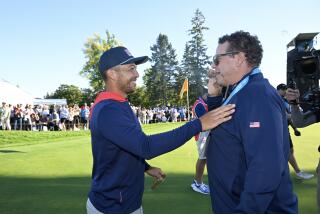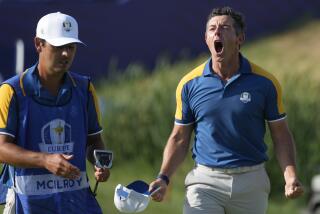U.S. Ryder Cup Team Needs Total Overhaul
- Share via
There is an expression in southern Europe, along the Mediterranean where the Ryder Cup was just played, that is appropriate: The fish rots from the head.
If the Ryder Cup is to be won back by the United States in 1999, there must be a rethinking of the loss to Europe that focuses from the head of the U.S. team down.
The PGA of America, captain Tom Kite and the best of the American players must share responsibility for the loss--the fifth time in the last seven Ryder Cups the U.S. side has failed to win.
The European Ryder Cup committee was cruelly honest in dealing with the Miguel Angel Martin dispute. It knew that even if his wrist recovered, he wouldn’t be in top form for the competition and wasted no time dumping him.
Maybe the matter wasn’t handled delicately, but Nick Faldo, Jesper Parnevik and Jose Maria Olazabal--one of whom wouldn’t have been on the team if Martin was--each won at least two points.
Would an out-of-condition Martin have won two points? And remember, the final score was 14 1/2-13 1/2.
With Martin, Europe likely does not win.
The PGA of America needs to realize the Ryder Cup is no longer a walkover for the Americans.
European captain Seve Ballesteros was brutally honest in his pairings and was an active captain, paying more attention to winning the Ryder Cup than to having a good time.
Ballesteros played four guys only twice: Ian Woosnam, who had played in seven Ryder Cups but was not playing well; rookies Thomas Bjorn and Darren Clarke; and Per-Ulrik Johansson, who had played in only one before.
Ballesteros also sent Faldo, Olazabal, Colin Montgomerie, Bernhard Langer and Lee Westwood out the maximum five times. Their matches accumulated nine of Europe’s 14 1/2 points.
Kite seemed handcuffed by an American sense of democracy or by his desire to make everyone happy. He played each man at least three times and Tiger Woods was the only American to play five matches.
Tom Lehman, Davis Love III, Justin Leonard and Mark O’Meara needed to be out there more often.
It was as if Kite had his pairings for every match set before he got to Valderrama and stuck with them despite what was happening on the course.
Kite could also be criticized for sticking with the Woods-O’Meara pairing too long--three times, resulting in two losses--and for spending too much time chauffeuring Michael Jordan around the course and chatting with former President George Bush.
Ballesteros had no time for such frivolity.
The U.S. team needs a nasty leader next time, someone like Curtis Strange or Hale Irwin who won’t be afraid to do what is right and not what is nice.
Europe also got the leadership it needed from its best players.
Faldo took Westwood by the hand and led him around Valderrama as they won two of the four matches they played together and took the other two to the 17th and 18th holes before losing.
Montgomerie was the verbal leader of the team, accurately pointing out that the tight Valderrama course was not the kind of layout Woods plays well.
Olazabal, who a year ago at this time could barely walk because of bad feet, played five matches in three days.
No one among the Americans stepped forward to take a leadership role, although Lehman was the most demonstrative on the course.
Woods, Leonard and Love--who won the Masters, British Open and PGA Championship this year--were involved in only one winning match and had only 2 1/2 points among them.
Meanwhile, Faldo, Montgomerie, Langer and Olazabal won at least two points each.
When Europe won the Ryder Cup in 1985 for only the second time in 50 years and the first time since 1957, the event suddenly had the attention of Americans.
“People wanted to know two things,” Love said. “What’s the Ryder Cup and why did we lose it?”
Because of the team format and nationalistic fervor, this is the most compelling event in golf. No longer do Americans want to know what the Ryder Cup is. Now they want to know only what the United States has to do to win it back.
The changes need to start at the top.
More to Read
Go beyond the scoreboard
Get the latest on L.A.'s teams in the daily Sports Report newsletter.
You may occasionally receive promotional content from the Los Angeles Times.










